The Effects of Age and Initial Shoulder Posture on the Upper Limb Range of Harvesting Movements among Oil Palm Harvesters
Abstract
:1. Introduction
2. Methods
2.1. Participants and Study Design
2.2. Experimental Procedure
3. Data Analysis
4. Results
4.1. Characteristics of the Participants
4.2. Harvesting Phases
4.3. Range of Harvesting Movement
5. Discussion
6. Conclusions
Author Contributions
Funding
Institutional Review Board Statement
Informed Consent Statement
Data Availability Statement
Acknowledgments
Conflicts of Interest
References
- Nawi, N.S.M.; Deros, B.M.; Ab-Rahman, M.N.; Sukadarin, E.H.; Nordin, N. Malaysian oil palm workers are in pain: Hazards identification and ergonomics related problems. Malays. J. Public Health Med. 2016, 16, 50–57. [Google Scholar]
- Ng, Y.G.; Tamrin, S.B.M.; Md Yusoff, I.S.; Mori, I.; Hashim, Z. Ergonomics observation: Harvesting tasks at oil palm plantation. J. Occup. Health 2013, 55, 405–414. [Google Scholar] [CrossRef] [PubMed] [Green Version]
- Deros, B.M.; Ali, M.H.; Mohamad, D.; Darius, D.D.I. Ergonomic risk assessment on oil palm industry workers. Iran. J. Public Health 2016, 45, 44–51. [Google Scholar]
- Ng, Y.G.; Tamrin, S.B.M.; Md Yusoff, I.S.; Hashim, Z.; Deros, B.M.; Bakar, S.A.; How, V. Risk factors of musculoskeletal disorders among oil palm fruit harvesters during early harvesting stage. Ann. Agric. Environ. Med. 2015, 22, 286–292. [Google Scholar] [CrossRef] [PubMed] [Green Version]
- Guturu, K.; Sahitya, K.; Komali, V.N.; Kiran, B.R.; Satyanarayana, C.V.V. Design and Fabrication of prototype telescopic raising platform for harvesting oil palm fresh fruit bunches. Indian J. Sci. Technol. 2015, 8, 1–5. [Google Scholar] [CrossRef]
- Ma, L.; Zhang, W.; Chablat, D.; Bennis, F.; Guillaume, F. Multi-objective optimisation method for posture prediction and analysis with consideration of fatigue effect and its application case. Comput. Ind. Eng. 2009, 57, 1235–1246. [Google Scholar] [CrossRef] [Green Version]
- Rahman, A.; Mohamaddan, S.; Majid, N.A.A.; Munot, M.A.; Yusuf, M.; Ngie, D.C.S.; Deros, B.M. Investigation of human arm musculoskeletal model using aluminium pole in palm oil harvesting process. In Proceedings of the 2016 IEEE EMBS Conference on Biomedical Engineering and Sciences (IECBES), Kuala Lumpur, Malaysia, 5–7 December 2016; pp. 394–399. [Google Scholar]
- Sukadarin, E.H.; Deros, B.M.; Nawi, N.S.M.; Ghani, J.A.; Ismail, A.R.; Zakaria, J. Back pain and the observed factors among oil palm workers. Int. J. Eng. Technol. Sci. 2016, 3, 70–78. [Google Scholar] [CrossRef]
- Bernard, C.; Courouve, L.; Bouée, S.; Adjémian, A.; Chrétien, J.-C.; Niedhammer, I. Biomechanical and psychosocial work exposures and musculoskeletal symptoms among vineyard workers. J. Occup. Health 2011, 53, 297–311. [Google Scholar] [CrossRef] [Green Version]
- Gustafsson, B.; Pinzke, S.; Isberg, P.E. Musculoskeletal symptoms in swedish dairy farmers. Swed. J. Agric. Res. 1994, 24, 177–188. [Google Scholar]
- Hildebrandt, V.H. Musculoskeletal symptoms and workload in 12 branches of Dutch agriculture. Ergonomics 1995, 38, 2576–2587. [Google Scholar] [CrossRef]
- McCurdy, S.A.; Samuels, S.J.; Carroll, D.J.; Beaumont, J.J.; Morrin, L.A. Agricultural injury in California migrant Hispanic farm workers. Am. J. Ind. Med. 2003, 44, 225–235. [Google Scholar] [CrossRef]
- Park, H.; Sprince, N.L.; Ma, P.S.W.; Burmeister, L.F.; Zwerling, C. Risk factors for back pain among male farmers: Analysis of Iowa farm family health and hazard surveillance study. Am. J. Ind. Med. 2001, 40, 646–654. [Google Scholar] [CrossRef]
- Xiang, H.; Stallones, L.; Keefe, T.J. Back pain and agricultural work among farmers: An analysis of the Colorado farm family health and hazard surveillance survey. Am. J. Ind. Med. 1999, 35, 310–316. [Google Scholar] [CrossRef]
- Latko, W.A.; Armstrong, T.J.; Franzblau, A.; Ulin, S.S.; Werner, R.A.; Albers, J.W. Cross-sectional study of the relationship between repetitive work and the prevalence of upper limb musculoskeletal disorders. Am. J. Ind. Med. 1999, 36, 248–259. [Google Scholar] [CrossRef]
- Marcus, M.; Gerr, F.; Monteilh, C.; Ortiz, D.J.; Gentry, E.; Cohen, S.; Ma, A.E.; Ensor, C.; Kleinbaum, D. A prospective study of computer users: II. Postural risk factors for musculoskeletal symptoms and disorders. Am. J. Ind. Med. 2002, 41, 236–249. [Google Scholar] [CrossRef]
- Md Yusoff, I.S.; Tamrin, S.B.M.; Mat-Said, A.; Ng, Y.G.; Mori, I. Oil palm workers: Designing ergonomics harvesting tool using user centered design approach to reducing awkward body posture by Catia simulation. Iran. J. Public Health 2014, 43, 72–80. [Google Scholar]
- Sukadarin, E.H.; Deros, B.M.; Ghani, J.A.; Ismail, A.R.; Nawi, N.S.M.; Abdull, N. Validity test for simple ergonomics risk assessment (Sera). Malays. J. Public Health Med. 2016, 16, 134–143. [Google Scholar]
- Chaffin, D.B.; Faraway, J.J.; Zhang, X.; Woolley, C. Stature, age, and gender effects on reach motion postures. Hum. Factors 2000, 42, 408–420. [Google Scholar] [CrossRef] [Green Version]
- Karniel, A.; Inbar, G.F. A model for learning human reaching movements. Biol. Cybern. 1997, 77, 173–183. [Google Scholar] [CrossRef]
- Chaffin, D.B. On simulating human reach motions for ergonomics analyses. Hum. Factors Ergon. Manuf. 2002, 12, 235–247. [Google Scholar] [CrossRef] [Green Version]
- Chateauroux, E.; Wang, X. Effects of Age, gender, and target location on seated reach capacity and posture. Hum. Factors 2008, 50, 211–226. [Google Scholar] [CrossRef]
- Chaffin, D.B.; Faraway, J.; Zhang, X. Simulating Reach Motions, SAE Technical Paper 1999-01-1916; SAE International: Warrendale, PA, USA, 1999. [Google Scholar] [CrossRef] [Green Version]
- Syuaib, M.F. Ergonomic of the manual harvesting tasks of oil-palm plantation in Indonesia based on anthropometric, postures and work motions analyses. Agric. Eng. Int. CIGR J. 2015, 17, 248–262. [Google Scholar]
- Kroemer, K.H.; Grandjean, E. Fitting the Task to the Human, 5th ed.; Taylor & Francis: Philadelphia, PA, USA, 1997; ISBN 020348391X. [Google Scholar]
- Openshaw, S.; Taylor, E. Ergonomics and Design: A Refererence Guide; Allsteel Inc.: Muscatine, IA, USA, 2006. [Google Scholar]
- McAtamney, L.; Corlett, E.N. RULA: A survey method for the investigation of work-related upper limb disorders. Appl. Ergon. 1993, 24, 91–99. [Google Scholar] [CrossRef]
- Templeton, G.F. A two-step approach for transforming continuous variables to normal: Implications and recommendations for IS research. Commun. Assoc. Inf. Syst. 2011, 28, 4. [Google Scholar] [CrossRef] [Green Version]
- Larsson, B.; Månsson, B.; Karlberg, C.; Syvertsson, P.; Elert, J.; Gerdle, B. Reproducibility of surface EMG variables and peak torque during three sets of ten dynamic contractions. J. Electromyogr. Kinesiol. 1999, 9, 351–357. [Google Scholar] [CrossRef]
- Herberts, P.; Kadefors, R.; Högfors, C.; Sigholm, G. Shoulder pain and heavy manual labor. Clin. Orthop. Relat. Res. 1984, 191, 166–178. [Google Scholar] [CrossRef]
- Punnett, L.; Fine, L.J.; Keyserling, W.M.; Herrin, G.D.; Don, B.; Monroe, W.; Herrin, D.; Fine, J. Articles original in automobile work disorders and postural shoulder assembly. Scand. J. Work Environ. Health 2000, 26, 283–291. [Google Scholar] [CrossRef] [Green Version]
- Svendsen, S.W.; Bonde, J.P.; Mathiassen, E.S.; Stengaard-Pedersen, K.; Frich, L.H. Work related shoulder disorders: Quantitative exposure-response relations with reference to arm posture. Occup. Environ. Med. 2004, 61, 844–853. [Google Scholar] [CrossRef] [PubMed] [Green Version]
- Hanvold, T.N.; Waersted, M.; Mengshoel, A.M.; Bjertness, E.; Veiersted, K.B. Work with prolonged arm elevation as a risk factor for shoulder pain: A longitudinal study among young adults. Appl. Ergon. 2015, 47, 43–51. [Google Scholar] [CrossRef] [PubMed]
- Gold, J.; Driban, J.; Thomas, N.; Chakravarty, T.; Channell, V.; Komaroff, E. Postures, typing strategies, and gender differences in mobile device usage: An observational study. Appl. Ergon. 2012, 43, 408–412. [Google Scholar] [CrossRef]
- Fagarasanu, M.; Kumar, S.; Narayan, Y. Measurement of angular wrist neutral zone and forearm muscle activity. Clin. Biomech. 2004, 19, 671–677. [Google Scholar] [CrossRef] [PubMed]
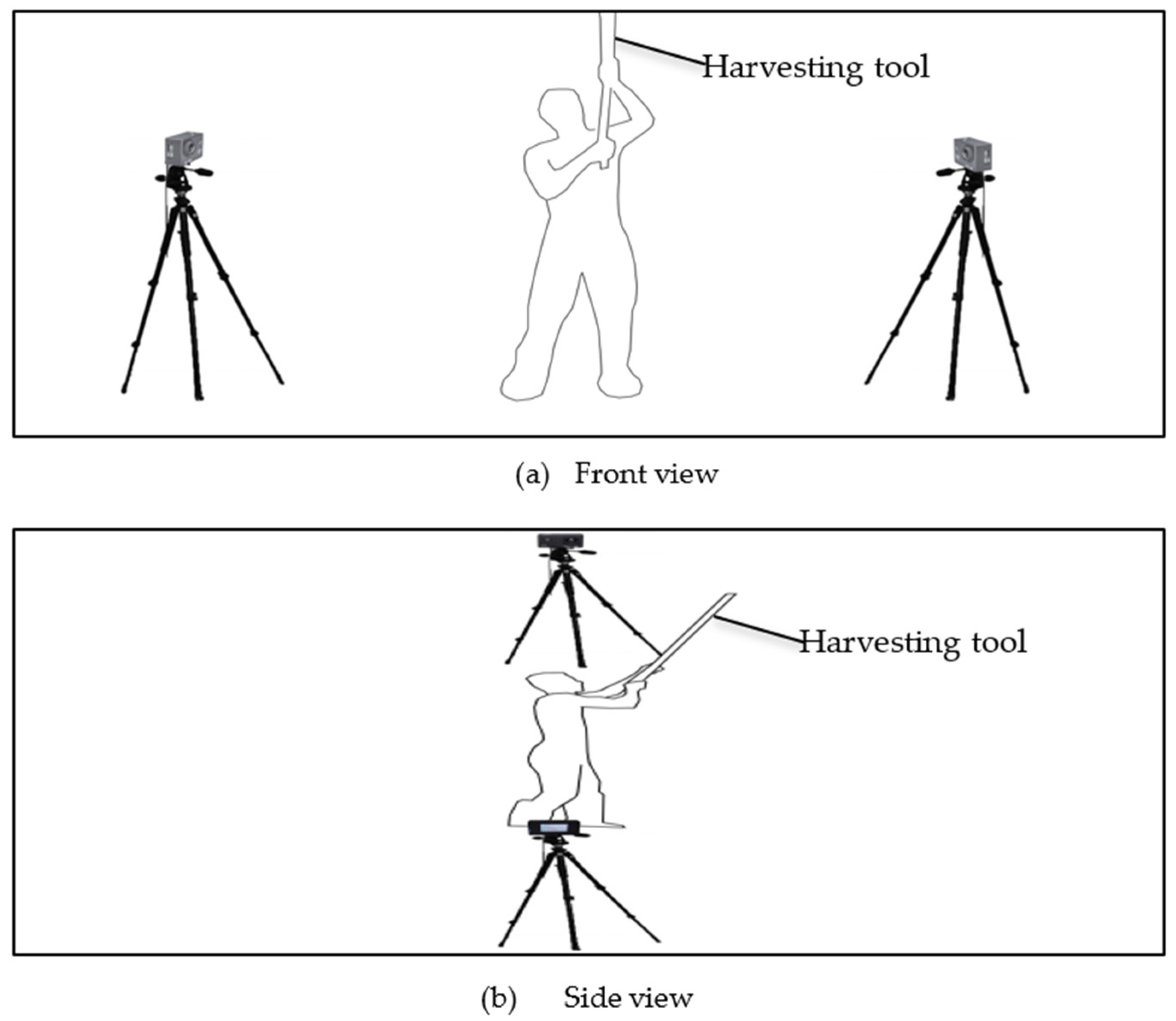
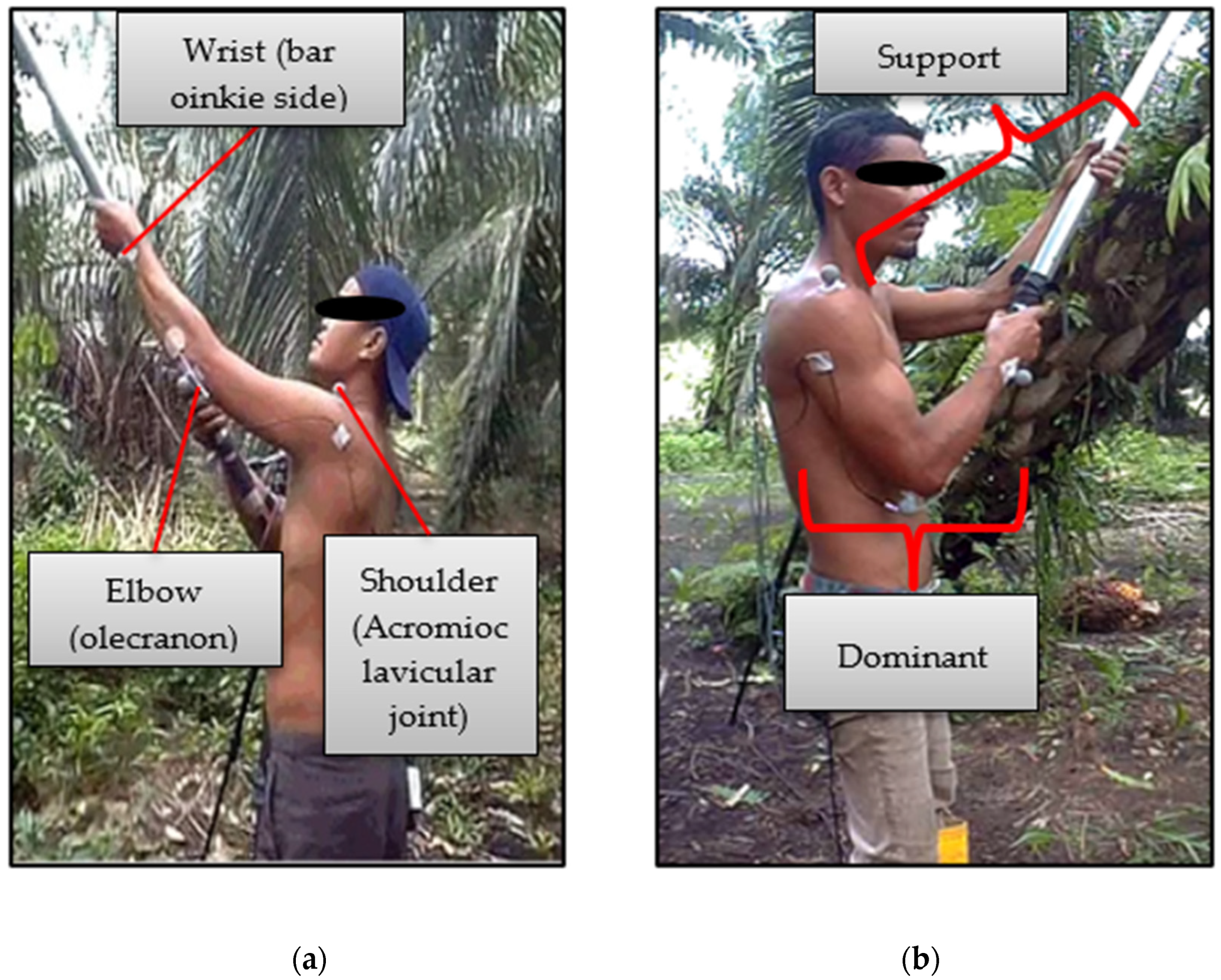


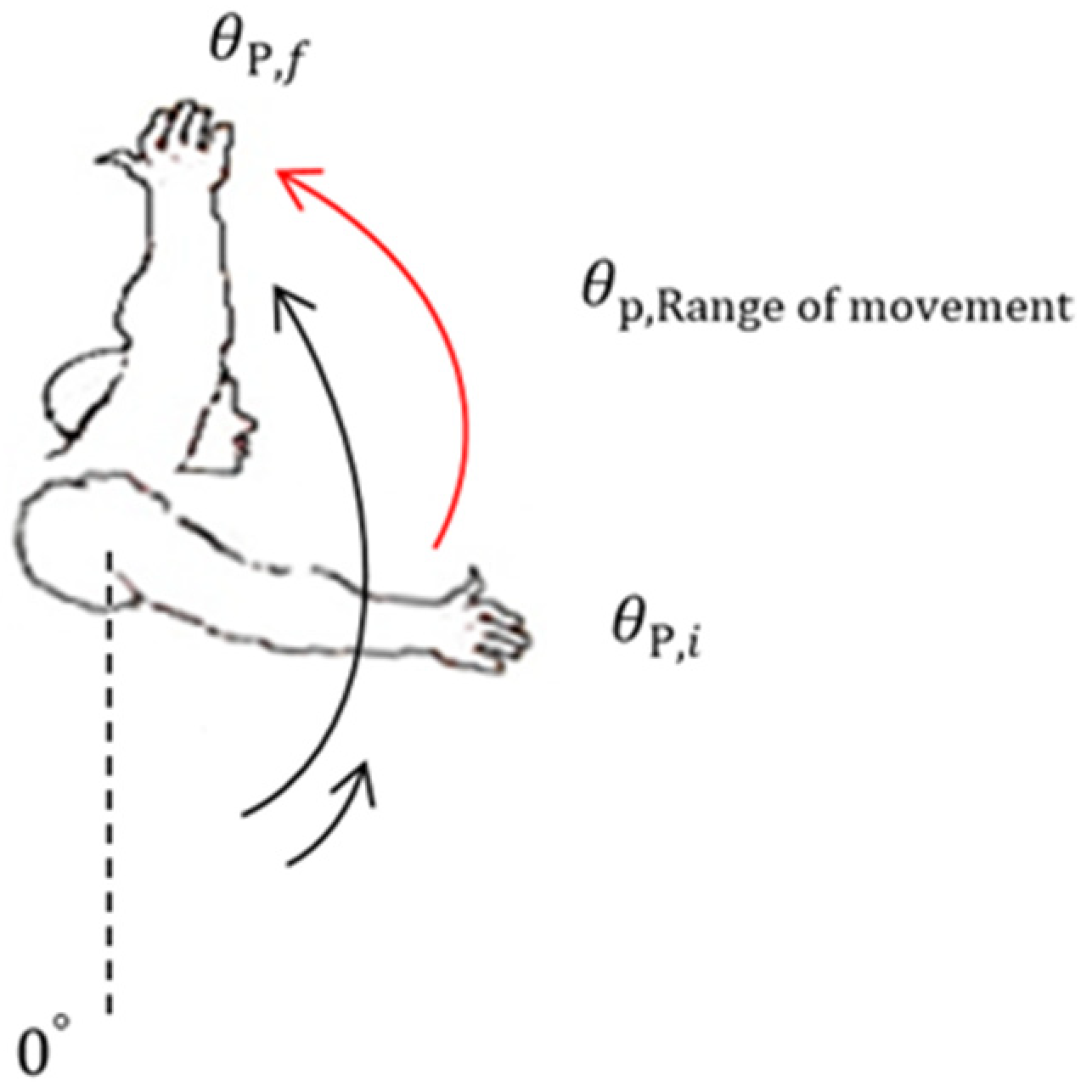
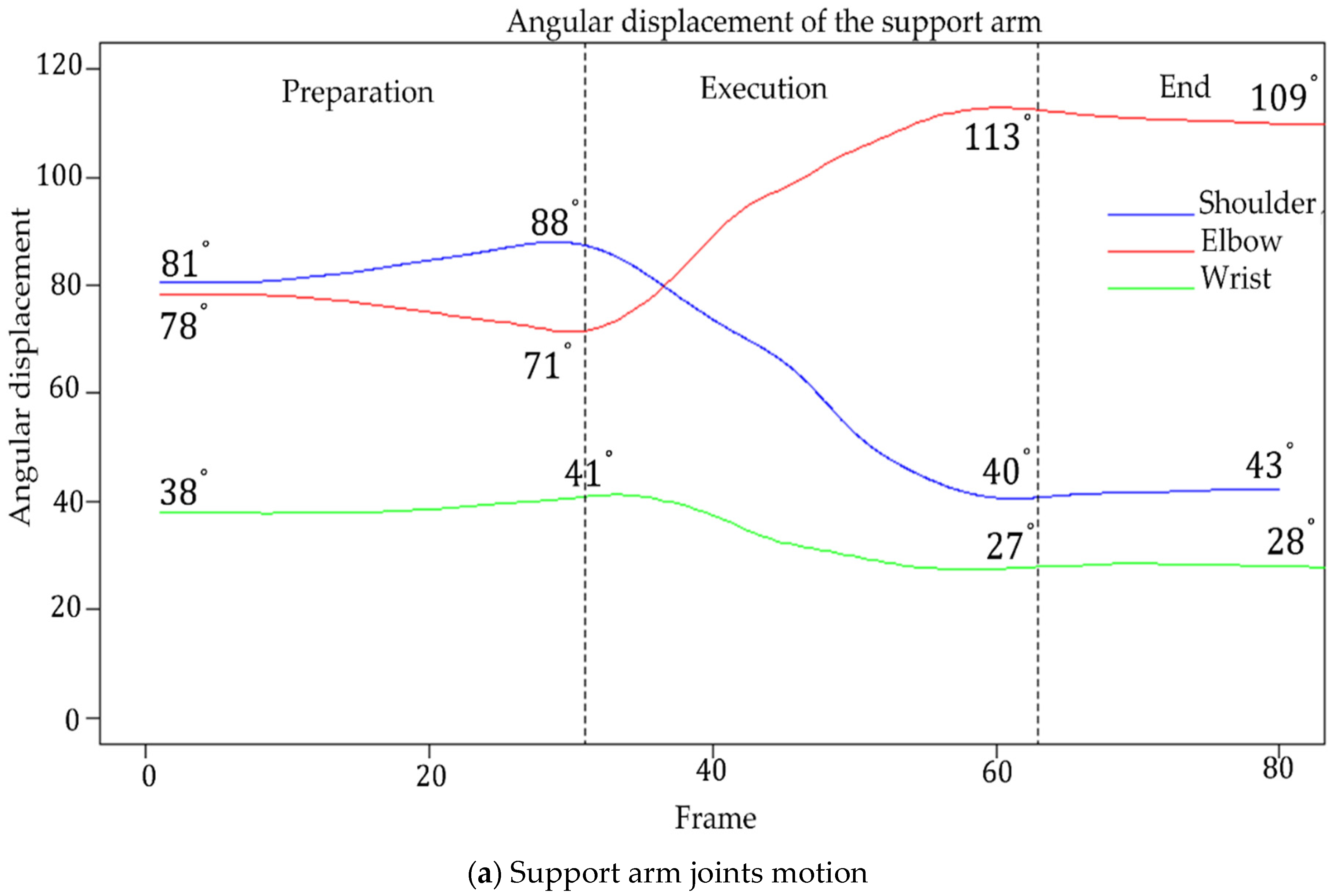
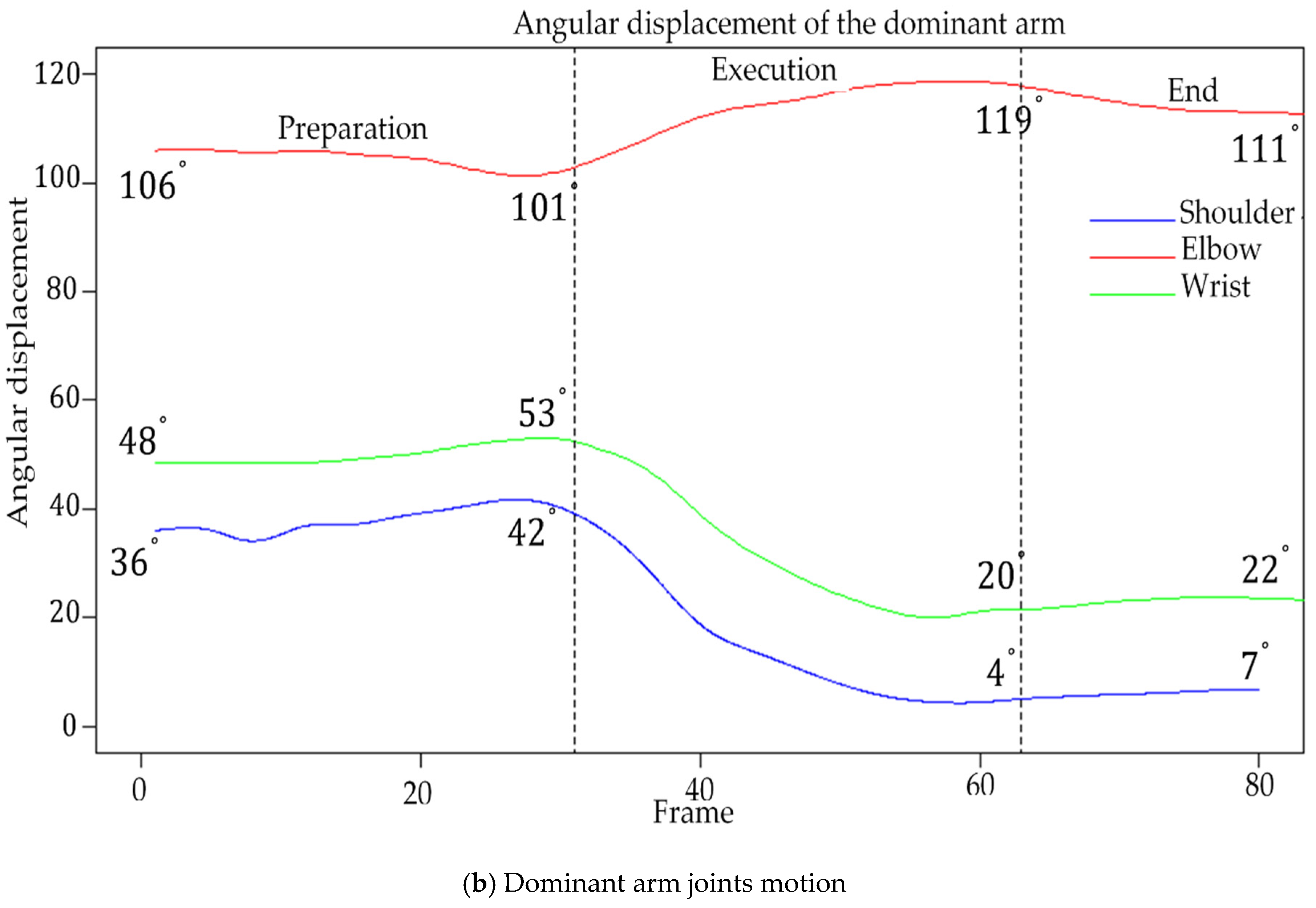
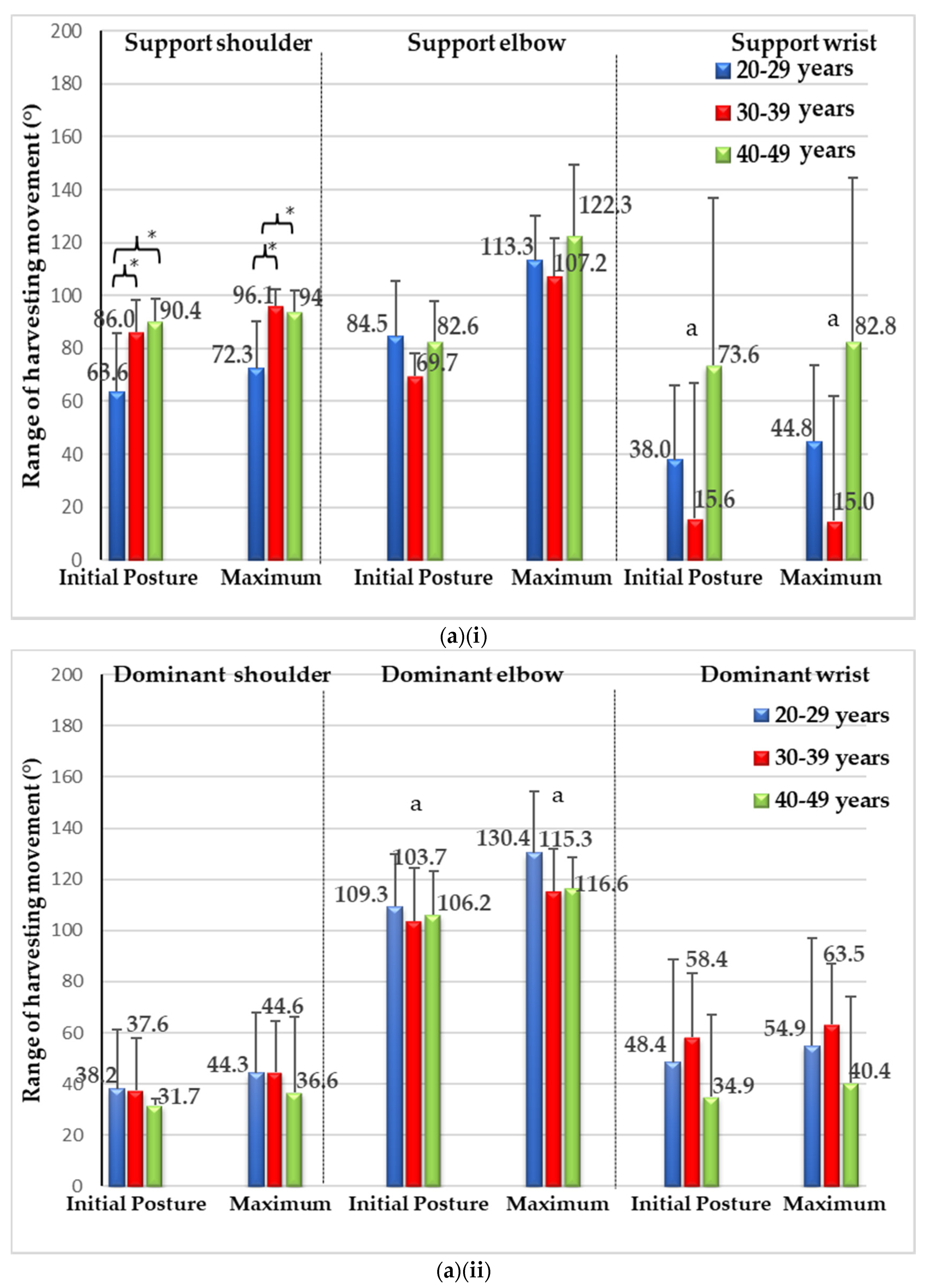

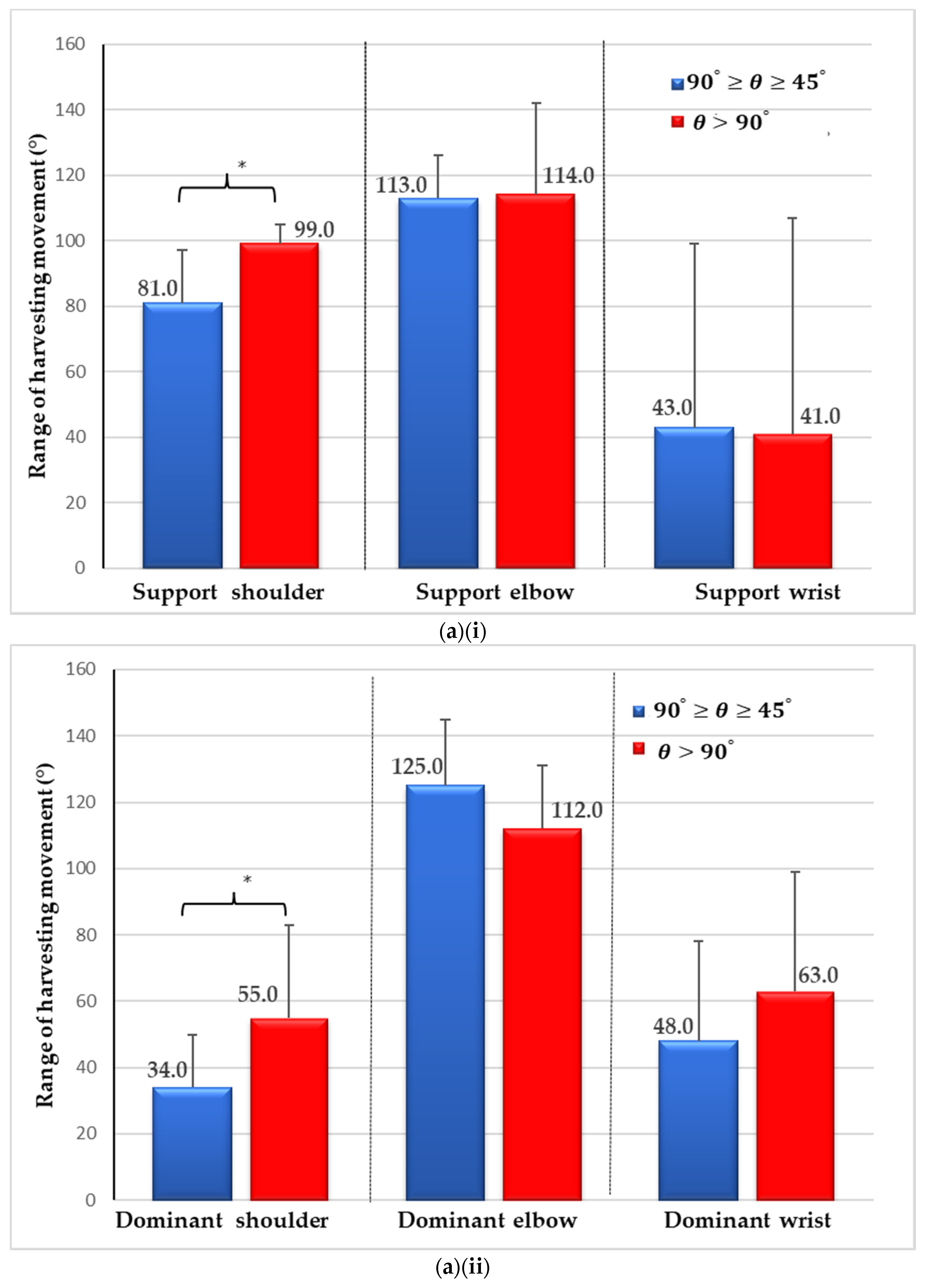
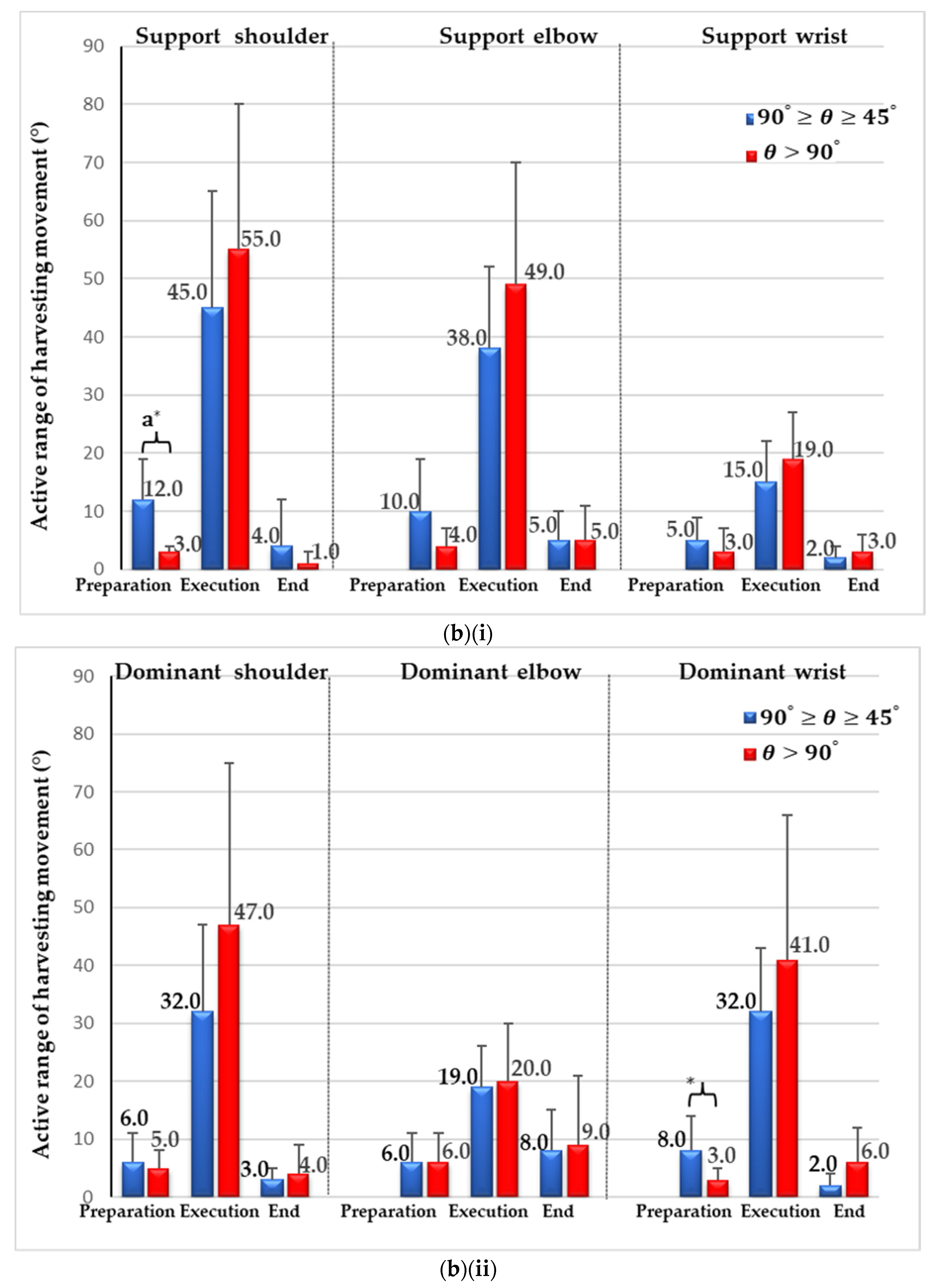
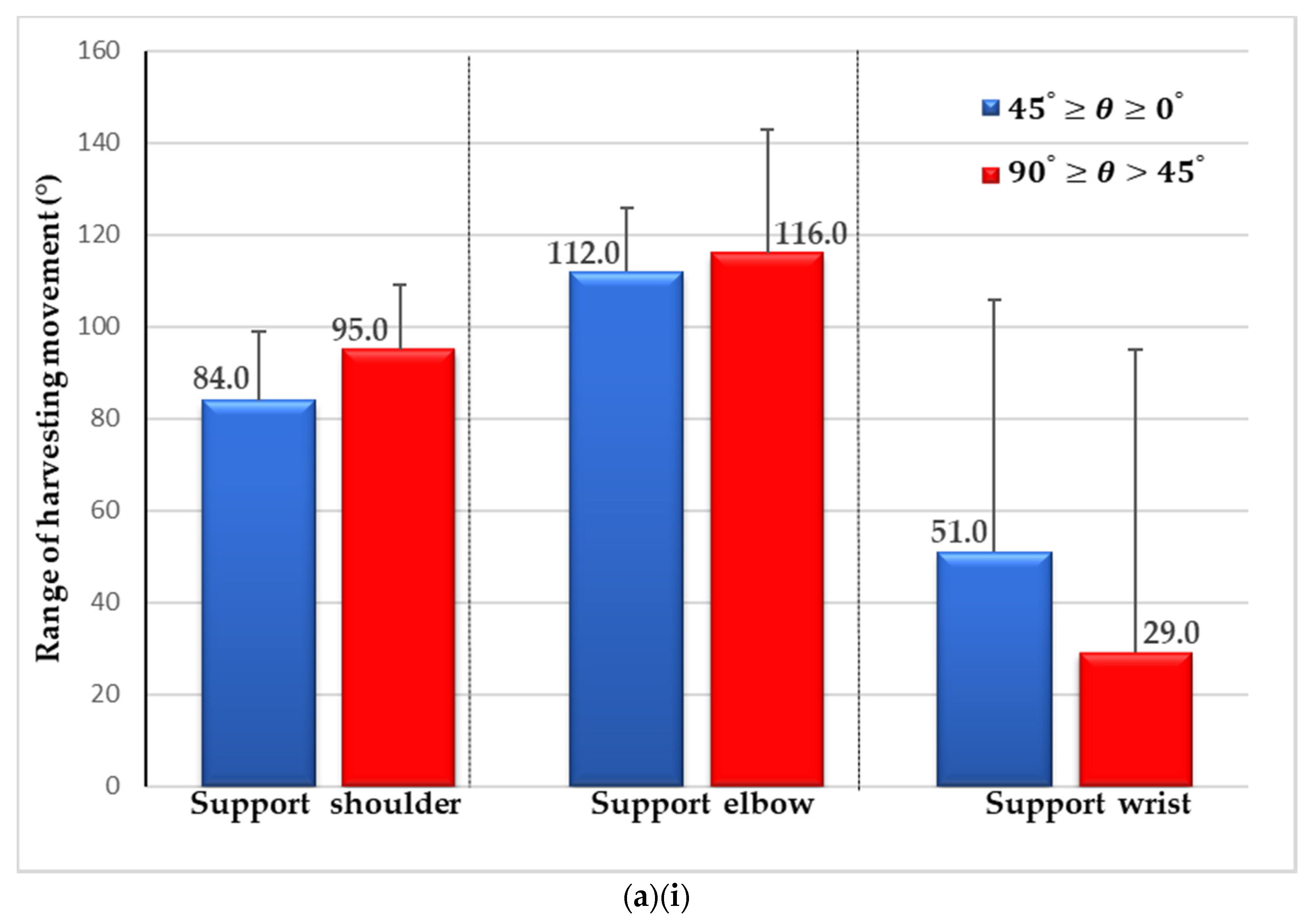
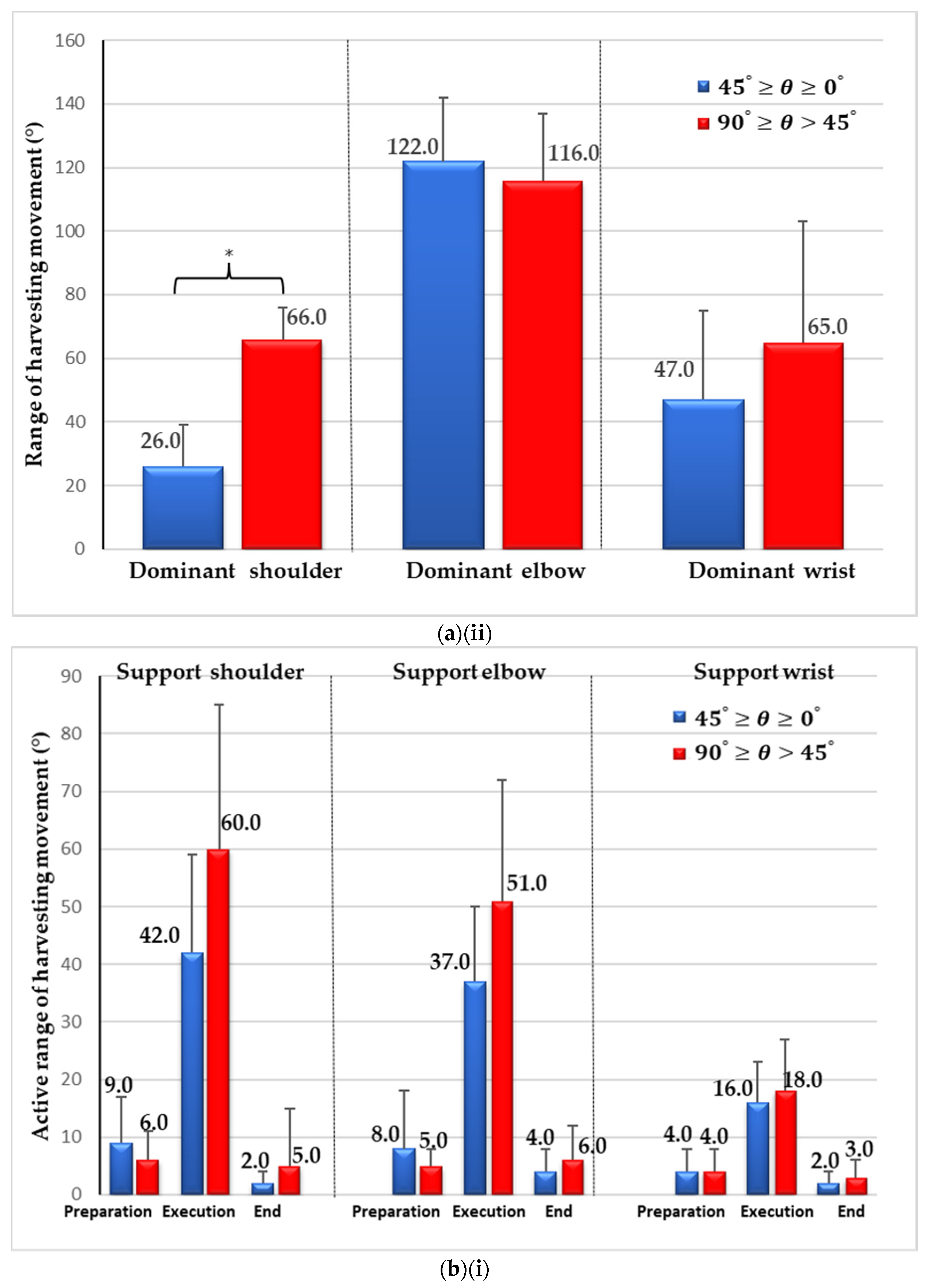

| Effect | Group, Years | Age | Wt, kg | Ht, cm | Upper Arm, cm | Lower Arm, cm | Hand, cm | |||
|---|---|---|---|---|---|---|---|---|---|---|
| S | D | S | D | S | D | |||||
| Age (years) | 20–29 (n = 6) | 26 ± 1 | 62.0 ± 7.0 | 166.0 ± 8.0 | 32.0 ± 4.0 | 32.0 ± 4.0 | 27.0 ± 3.0 | 27.0 ± 4.0 | 9.0 ± 1.0 | 10.0 ± 2.0 |
| 30–39 (n = 8) | 35 ± 3 | 64.0 ± 9.0 | 162.0 ± 5.0 | 34.0 ± 6.0 | 32.0 ± 1.0 | 26.0 ± 1.0 | 26.0 ± 1.0 | 9.0 ± 1.0 | 10.0 ± 2.0 | |
| 40–49 (n = 6) | 43 ± 4 | 60.0 ± 6.0 | 160.0 ± 5.0 | 33.0 ± 2.0 | 32.0 ± 2.0 | 26.0 ± 1.0 | 26.0 ± 1.0 | 10.0 ± 1.0 | 10.0 ± 1.0 | |
| Effect | Group | Age | Wt, kg | Ht, cm | Upper Arm, cm | Lower Arm, cm | Hand, cm | |||
|---|---|---|---|---|---|---|---|---|---|---|
| S | D | S | D | S | D | |||||
| Initial Support Shoulder | θ > 90°, RULA = 4, (n = 8) | 38 ± 8 | 62.6 ± 5.5 | 163.4 ± 5.5 | 33.0 ± 1.0 | 33.0 ± 2.0 | 26.0 ± 1.0 | 26.0 ± 2.0 | 9.0 ± 1.0 | 9.0 ± 1.0 |
| 90° ≥ θ ≥ 45°, RULA = 3, (n = 12) | 33 ± 6 | 61.6 ± 8.6 | 161.6 ± 6.4 | 33.0 ± 5.5 | 32.0 ± 3.0 | 26.0 ± 2.0 | 26.0 ± 3.0 | 9.0 ± 1.0 | 10.0 ± 2.0 | |
| Initial Dominant Shoulder | 90° ≥ θ 45°, RULA = 3, (n = 8) | 34 ± 7 | 61.1 ± 7.0 | 161.6 ± 6.3 | 32.0 ± 3.0 | 32.0 ± 4.0 | 26.0 ± 2.0 | 26.0 ± 3.0 | 9.0 ± 1.0 | 9.0 ± 2.0 |
| 45° ≥ θ ≥ 0, RULA = 1–2, (n = 12) | 35 ± 7 | 62.6 ± 7.8 | 162.8 ± 5.9 | 34.0 ± 5.0 | 32.0 ± 2.0 | 27.0 ± 2.0 | 27.0 ± 2.0 | 10.0 ± 1.0 | 10.0 ± 2.0 | |
Publisher’s Note: MDPI stays neutral with regard to jurisdictional claims in published maps and institutional affiliations. |
© 2021 by the authors. Licensee MDPI, Basel, Switzerland. This article is an open access article distributed under the terms and conditions of the Creative Commons Attribution (CC BY) license (https://creativecommons.org/licenses/by/4.0/).
Share and Cite
Tumit, N.P.; Rambely, A.S.; Deros, B.M. The Effects of Age and Initial Shoulder Posture on the Upper Limb Range of Harvesting Movements among Oil Palm Harvesters. Appl. Sci. 2021, 11, 10280. https://doi.org/10.3390/app112110280
Tumit NP, Rambely AS, Deros BM. The Effects of Age and Initial Shoulder Posture on the Upper Limb Range of Harvesting Movements among Oil Palm Harvesters. Applied Sciences. 2021; 11(21):10280. https://doi.org/10.3390/app112110280
Chicago/Turabian StyleTumit, Nelson Pady, Azmin Sham Rambely, and Baba Md Deros. 2021. "The Effects of Age and Initial Shoulder Posture on the Upper Limb Range of Harvesting Movements among Oil Palm Harvesters" Applied Sciences 11, no. 21: 10280. https://doi.org/10.3390/app112110280
APA StyleTumit, N. P., Rambely, A. S., & Deros, B. M. (2021). The Effects of Age and Initial Shoulder Posture on the Upper Limb Range of Harvesting Movements among Oil Palm Harvesters. Applied Sciences, 11(21), 10280. https://doi.org/10.3390/app112110280






